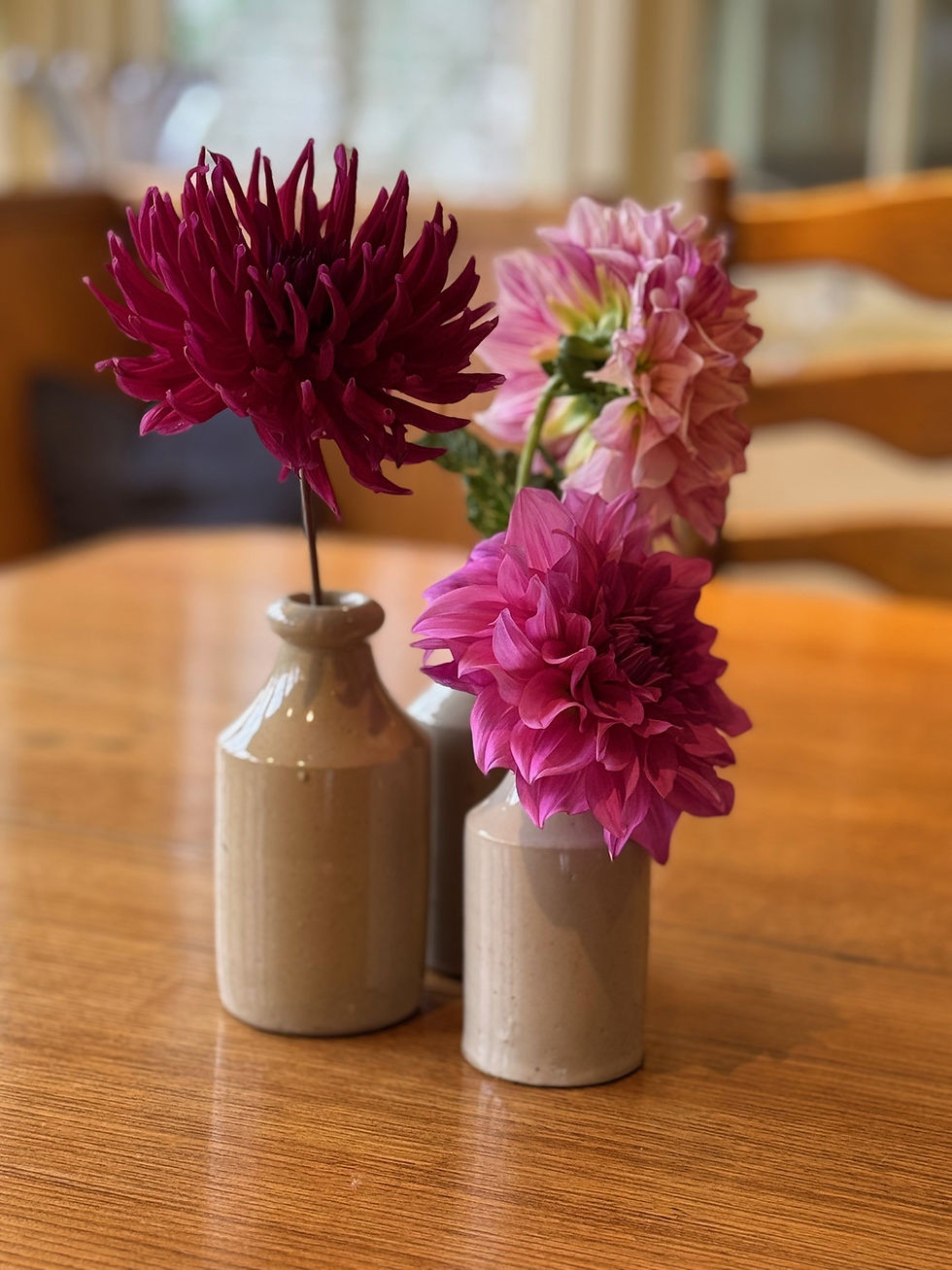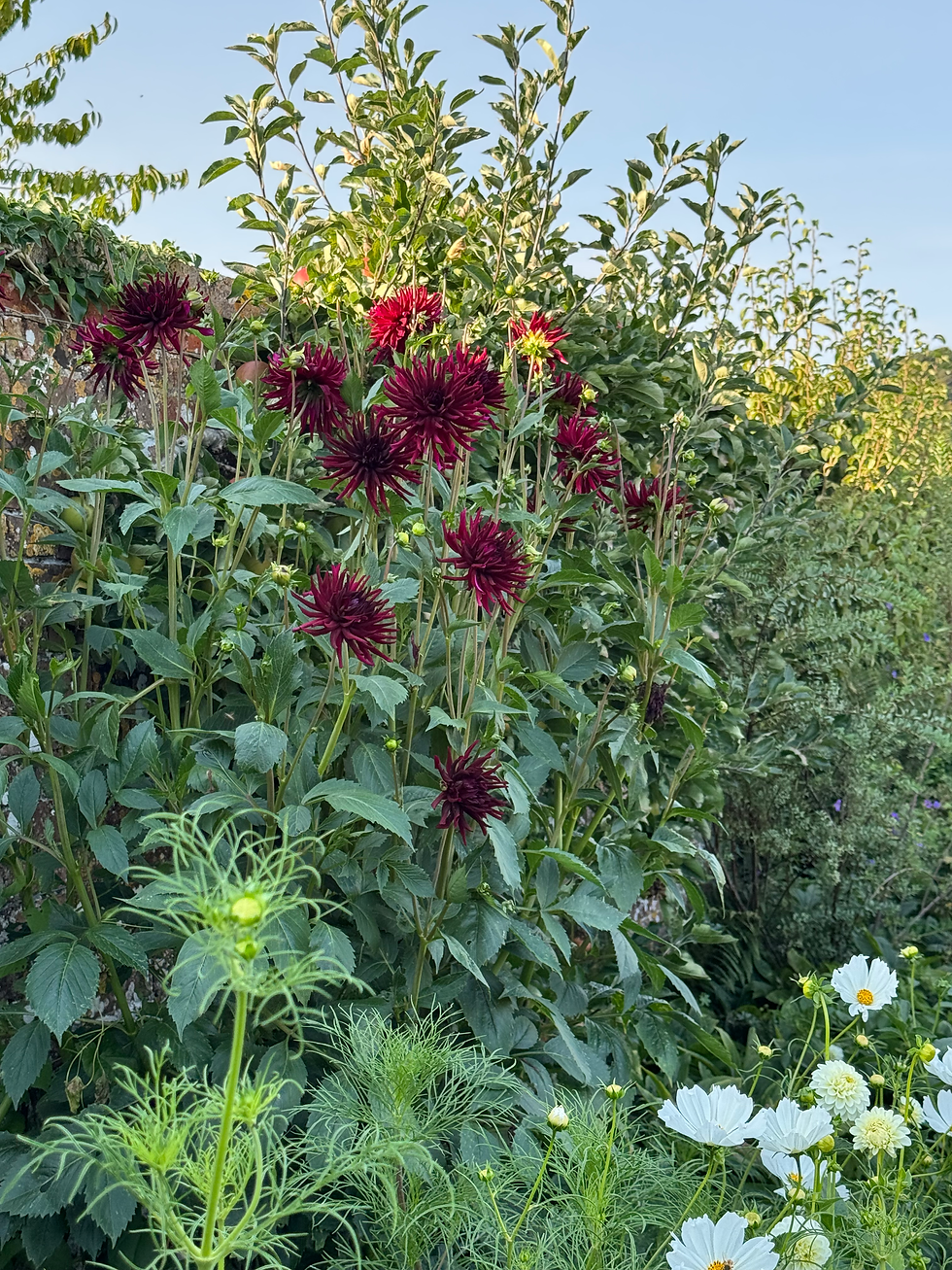August – an enduring love
- katyelton8
- Aug 27
- 6 min read
If we were asked for the defining plant of Gasper Cottage, it would without question be the dahlia. Not only is does this late summer perennial feature in many forms (at last count, there were more than 30 different cultivars planted throughout the garden), it also plays an integral role in the garden's history.

Until encouraged by her sister-in-law Sara to grow dahlias for the local village show, Bella had taken little more than a cursory interest in her garden – then a basic and functional design with more than its fair share of lawn. Dahlias though, with their myriad of forms and colours, stirred something in her artistic sensibilities, and the ease with which they thrived on Gasper's sandy soil gave her confidence to experiment with other plants.
Before long she was hooked, devouring gardening books and magazines and finding herself in the grip of a new obsession. In 2005, with the help of garden designer Sasha Langton-Gilks, she gave the garden a complete overhaul, creating much of the structure and layout we see today.

Though Bella's tastes and knowledge have evolved considerably since these early gardening dalliances, her fondness for dahlias remains undiminished. After many years of collecting and trialling different varieties, she is, however, well-placed to comment on industry shortcomings:
"There are so many cultivars, many of which are sold as the same plant by different suppliers but which do not resemble each other in the slightest, or you may have two which seem very much the same but are sold under different names".
"The information offered by suppliers also leaves a lot to be desired. There tends to be lots of detail on the flower – size, form, colour etc., yet they are much more woolly on how big the plant will get, how vigorous it will be, how desperate it is to be staked, and the length of the usable stem on each flower. Not to mention how attractive (or not) the foliage may be".
Her love for dahlias outweighing these frustrations, she continues to experiment with new and intriguing varieties, yet even after more than two decades choosing the right position continues to be a work in progress:
"My general rule of thumb is to place them where their relatively ugly foliage is not in your face, but the the plant is still accessible for picking and deadheading. Despite this, I do still get it wrong sometimes, a prime example at the moment being Dahlia merckii".
With small, fleeting flowers, this species ideally needs deadheading daily during its blooming period, though its fairly inaccessible position at the back of a border in the front garden makes this difficult.
"The theory", explains Bella, "was that it would thrive in the hot dry conditions back there, however the reality is a fairly permanent mess of small dead flowers. Even in bloom, the pale mauve flowers get lost against the limewashed walls of the front of the house. Either it needs to be relocated to a better position, or I give up on this delicate, subtle form and replace it with something more bold and visible from the path!".

As well as using dahlias to provide late season colour and interest in the garden, Bella regularly cuts their flowers for the house. Of the conflict of interest this causes, she notes:
"The giant 'decorative' blooms are a bit of an issue in the borders, where they can look out of scale and tend to be produced by relatively inelegant plants. The problem is I love having them in the house, where I display them in a line of old tin glaze stoneware bottles. For someone with limited flower arranging skills this gives impact with no stress. It also tends to pass the Johnnie test of “are those flowers in the way of my conversation across the table? If they are I will move them."".


Bella also recognises that, with their highly double, often impenetrable flower forms, many of the dahlias she loves have little or no value to pollinators, making them at odds with the ethos of the garden.




"How I reconcile this is by thinking there is never a shortage of things to delight insects in this garden, so I would hope they allow me the odd indulgence with flowers that I can pick for months on end, and that give such wow factor to the garden in late summer. We also often accompany dahlias with lashings of cosmos which, with their lovely, open, pollinator-friendly flower forms, hopefully offer some compensation".



For those with heavy soil who have to lift and dry store their dahlia tubers each year to protect them from winter wet, the idea of having so many dahlias in a garden may seem faintly terrifying. However with Gasper having such light, free-draining soil and relatively mild winters, Head Gardener Jack can simply cut them back and leave them in the ground like any other perennial. With an insulating mound of mulch to buffer tubers from worst of the frost, he can be quite confident they'll emerge unscathed the following year. Their one special treatment is the marking of their location with a short cane:
"When left in the ground dahlias can be quite late to come into growth, so if they're not marked it's easy to forget they're there", he explains. "We've had a few cases of forgotten plants being smothered by spring bedding or self-sown annuals that we've failed to clear away in time to allow light through to the new shoots".

"Other than that we don't usually have any problems. While you wouldn't exactly call them low maintenance – they can be quite hungry, often need staking, and take plenty of deadheading – they're so well matched to our conditions that you can always rely on them to put on a good show".
He adds, "leaving them in the ground as we do is not only easier, but also makes for bigger, stronger plants and is why people are often so impressed by their performance here".
That said, even by usual standards this year has been special. A seemingly never ending stream of heatwaves has resulted in a particularly impressive display from these sun-loving Mexican and Central American natives, many of which have already been flowering their socks off for several weeks.
With such splendour filling the garden it might be difficult to pick out a particular favourite, though for Bella one is easily more precious than the rest. In the centre of the Studio Garden is a dahlia with deep ruby red blooms called Dahlia 'DD Langton-Gilks', named after the son of garden designer Sasha who very sadly died of a brain tumour in 2012, aged 16.
DD's initial diagnosis came a couple of years after Sasha and Bella had worked together on the garden redesign, and in a further converging of lives he was in Southampton Hospital at the same time as Bella's son Tom, who spent time in its orthopaedic ward following a serious car accident.
The dahlia which marks the all-too-short life of her friend's son is not available commercially, and so having been entrusted with a plant by Sasha, Bella has taken the utmost care to ensure it thrives here at Gasper Cottage.

While every plant has a story to tell, it's hard to think of one more inextricably linked with life at Gasper Cottage than the dahlia. There is little doubt the collection will continue to grow and evolve in the future, though, for now, we leave you with a few current highlights.








❤️ Love is a beautiful feeling that brings joy and connection into our lives. With Delhi Escorts, you can experience true affection, care, and companionship that make every moment unforgettable. 💃🌹✨